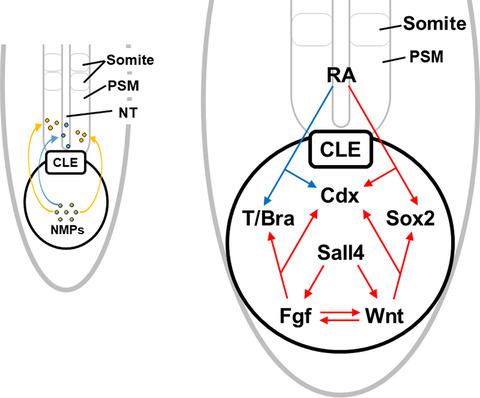当前位置:
X-MOL 学术
›
Dev. Growth Differ.
›
论文详情
Our official English website, www.x-mol.net, welcomes your feedback! (Note: you will need to create a separate account there.)
How do signaling and transcription factors regulate both axis elongation and Hox gene expression along the anteroposterior axis?
Development, Growth & Differentiation ( IF 2.5 ) Pub Date : 2020-05-23 , DOI: 10.1111/dgd.12682 Seiji Saito 1 , Takayuki Suzuki 2
Development, Growth & Differentiation ( IF 2.5 ) Pub Date : 2020-05-23 , DOI: 10.1111/dgd.12682 Seiji Saito 1 , Takayuki Suzuki 2
Affiliation

|
In vertebrates, vertebral primordia, called somites, are formed from the head to the tail along the anteroposterior axis of the body during development. The presomitic mesoderm (PSM), which differentiates into somites, is formed by continuous supply of new cells derived from the caudal lateral epiblast (CLE), resulting in body axis posterior elongation. Previous studies of mutants identified genes for posterior extension and vertebral patterning along the anteroposterior axis. Hox gene has been extensively investigated for its expression pattern and transcriptional regulation. In recent years, to elucidate the mechanism that controls the expression patterns of Hox genes, researchers have not only searched for enhancer regions and the transcription factors that bind to them but have also investigated chromatin structure, epigenetics and non‐coding RNA associated with Hox gene expression. These new findings reveal that the previously identified genes essential for posterior body axis elongation of the embryo determine positional information along the anteroposterior axis by induction of Hox genes via enhancer regions. In this review, we focus on genes that control posterior elongation and vertebral patterning along the anteroposterior axis in the PSM and CLE. We first describe the mechanism of maintenance of the stem cell‐like cell populations at the CLE, which is essential for the posterior elongation of the embryo. Next, the factors involved in posterior region formation and patterning of the vertebra are described. Finally, we discuss the regulatory mechanism of Hox gene expression and the mechanism that is responsible for the differences in skeletal pattern between species.
中文翻译:

信号传导和转录因子如何调节前后轴的轴伸长和Hox基因表达?
在脊椎动物中,在发育过程中,沿身体的前后轴从头到尾形成椎原基,即所谓的节节。持续分化为体节的中胚层(PSM)是通过持续供应来自尾侧上皮细胞(CLE)的新细胞而形成的,导致体轴向后延伸。突变体的先前研究确定了沿前后轴的后延伸和椎骨构图基因。Hox基因的表达方式和转录调控已被广泛研究。近年来,为了阐明控制Hox基因表达模式的机制,研究人员不仅搜索了增强子区域和与其结合的转录因子,还研究了染色质结构,与Hox基因表达相关的表观遗传学和非编码RNA。这些新发现揭示了先前鉴定的对于胚胎的后体轴伸长必不可少的基因,其通过增强子区域诱导Hox基因来确定沿前后轴的位置信息。在这篇综述中,我们关注于控制PSM和CLE中沿前后轴的后延伸和椎骨形态的基因。我们首先描述在CLE维持干细胞样细胞群体的机制,这对于胚胎的后延长至关重要。接下来,描述与椎骨的后部区域形成和图案化有关的因素。最后,
更新日期:2020-06-29
中文翻译:

信号传导和转录因子如何调节前后轴的轴伸长和Hox基因表达?
在脊椎动物中,在发育过程中,沿身体的前后轴从头到尾形成椎原基,即所谓的节节。持续分化为体节的中胚层(PSM)是通过持续供应来自尾侧上皮细胞(CLE)的新细胞而形成的,导致体轴向后延伸。突变体的先前研究确定了沿前后轴的后延伸和椎骨构图基因。Hox基因的表达方式和转录调控已被广泛研究。近年来,为了阐明控制Hox基因表达模式的机制,研究人员不仅搜索了增强子区域和与其结合的转录因子,还研究了染色质结构,与Hox基因表达相关的表观遗传学和非编码RNA。这些新发现揭示了先前鉴定的对于胚胎的后体轴伸长必不可少的基因,其通过增强子区域诱导Hox基因来确定沿前后轴的位置信息。在这篇综述中,我们关注于控制PSM和CLE中沿前后轴的后延伸和椎骨形态的基因。我们首先描述在CLE维持干细胞样细胞群体的机制,这对于胚胎的后延长至关重要。接下来,描述与椎骨的后部区域形成和图案化有关的因素。最后,



























 京公网安备 11010802027423号
京公网安备 11010802027423号